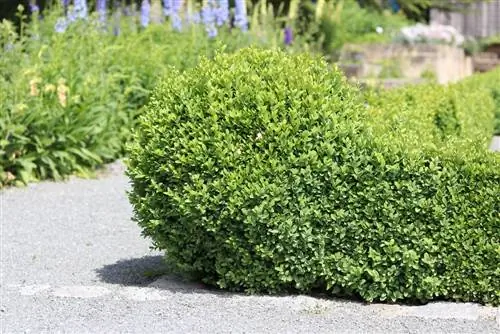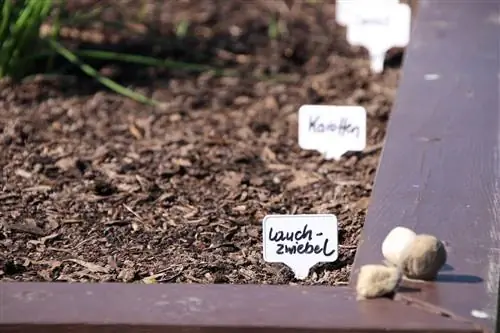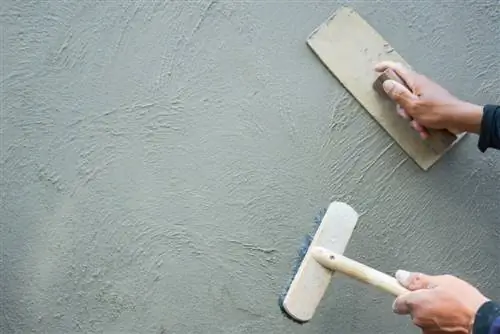- Author admin [email protected].
- Public 2023-12-17 03:39.
- Last modified 2025-01-24 12:45.
Slow-growing and versatile, with its small evergreen leaves decorative all year round - it's actually a shame that the boxwood needs a protective cover to overwinter in the cool part of Germany. Especially as a young tree and in a pot, but there are a few ways to decorate this winter protection in an attractive way. If a frostbitten boxwood should/must be replaced, get to know some boxwood varieties that have proven to be particularly frost-hardy even when grown in containers:
The winter hardiness of the boxwood
The “common boxwood” Buxus sempervirens, which we are so familiar with, is not a native plant; original stocks grow in North Africa, western Asia, but only in the warm south of Europe (northern Spain, southwestern France, southern England, the Balkans).
However, the boxwood had “a little time” to acclimatize with us: the Romans probably already cultivated boxwood hedges in what later became southern Germany; The boxwood certainly came to Germany in the Renaissance at the latest, after the court gardener of Henry IV made it the most sought-after garden decoration for the “VIPs” of the time. Ancient box forests, e.g. B. on the dream hiking trail through the mountain gorges of the Ehrenburg in the Brodenbachtal on the Moselle or near Grenzach-Wyhlen (Lörrach district, in the southwest of Baden-Württemberg) show that box trees can survive without any problems in a friendly German climate.
But in Germany there is not only a friendly climate (with hardiness zones 7b to 8a, on the Lower Main and in the Rhine Graben), but around Rosenheim, Amberg and Hof there are cool locations with winter hardiness zones 6a and in the Alpine region even the cold winter hardiness zone 5b (and of course everything in between).
The “inventors” of the winter hardiness zones, the US Department of Agriculture, divided the USA into climate zones a good 50 years ago based on the average maximum winter cold measured up to that point. In 1984, two dendrologists (tree scientists) calculated “the Central European values” of the USDA map and published them in a specialist journal; other countries adopted these values or created their own maps. The “USDA hardiness” (USDA winter hardiness determined by zone) is now the international standard when information is needed as to which region a plant can survive a normally cold winter.
Buxus sempervirens is assigned to winter hardiness zones 6 to 8, so in some corners of Germany the boxwood is not considered hardy, even if it should be planted outside in the garden soil (especially not in a pot, we'll get to that in a moment). You can find the winter hardiness zones clearly listed at the German Weather Service. You can also access the German Climate Atlas, with winter temperatures where you live and comprehensive calculations, data and maps on how the winter hardiness zones and the climate will change as a result of global warming in Germany: www.dwd.de/EN/ourservices/ germanclimateatlas/explanations/elements/erl_winterhaertezeln.html.
If you live in one of the critical zones and are about to purchase the boxwood, you should ask the seller about the winter hardiness zone of the boxwoods on offer or make sure that you purchase one of the particularly frost-hardy boxwood varieties (to the varieties see below).
It depends on the microclimate
If you live in a rather cool area of Germany and only found out after buying the boxwood that boxwood is not necessarily a frost-hardy native plant, good shopping advice will be of little use to you. If the boxwood was not purchased from a specialist nursery or tree nursery, there was probably neither variety advice (at least not with regard to winter hardiness) nor information about the winter hardiness zone.
Such “bargains” are not a problem for experienced gardeners, but are all the more annoying for new gardeners when the lack of product information (the lack of which they do not necessarily know anything about) has led to the purchase of the wrong variety, whose survival is now at stake the game stands. In this situation, you can benefit from the fact that the indication of the winter hardiness zone refers not only to the average winter cold, but also to an average location: winter hardiness is, so to speak, only one side of the coin, the gray theory, what is really important is the specific situation Location, the microclimate of the location.
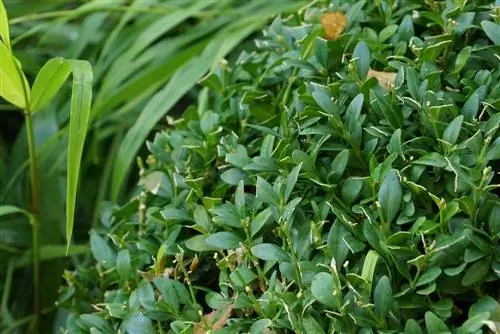
That's why even a boxwood variety that is more sensitive to cold has a good chance of “becoming happy with you” if you make sure to offer the cold-sensitive boxwood a protected location with a microclimate in which it thrives in cooler regions can develop. In the case of endangered boxwoods, the culture should be geared towards problem-free overwintering right from the start:
- Do not place boxwood pots in the blazing sun
- If the box is a little cold during the season, it hardens and prevents frost damage
- Fertilize correctly: under-supply, over-fertilization, wrong timing also influence winter hardiness
- Underfed plants lack energy=vitality to defend against frost
- Overfertilization creates a lot of fine, weak plant tissue that cannot withstand frost
- Late, generous nitrogen applications in particular are unfavorable for resistance to cold
- Give potassium fertilizer in September, which promotes the ripening (lignification) of the new shoots
- The boxwood in the pot is mobile and can move to the optimally cozy location over the winter
- The most important thing is protection from cold wind
- The coldest wind usually comes from the east or north, a location in the west or south significantly increases the chances of survival in winter
- Specific advantages of the environment should be used: house wall, hedge or a hill just behind the property fence can noticeably increase the temperatures in the area
- Cold-sensitive plants are most beautiful on the south side close to the house wall, which is why espaliered fruit was traditionally grown there in the past
- Be careful with direct sunlight, which exposes the pot to dangerous temperature fluctuations in winter
- If a location is protected from wind by buildings, overwintering on the east or north side is also conceivable
If the perfect winter location is difficult to find, you can also overwinter the boxwood in a cool, bright side room or basement. Or you can bury it and its pot in the ground, where it will overwinter like an outdoor plant. Then the boxwood should already be quite strong and acclimatized on site since at least early summer, because:
Young plants and potted plants always need good winter protection
Depending on the winter hardiness zone where you live and the microclimate of the location, you can assess whether an adult box tree can survive the winter in your garden under normal conditions (in the garden soil).
A young plant is a lot more sensitive than the adult plant, pot culture is not the norm for plants. Young plants of species that are just hardy here definitely need winter protection, even for several years depending on how they grow and thrive. Potted plants do not have several meters of soil underneath them in which they can warm their roots if in doubt. The volume of soil in the pot is more likely to freeze completely at temperatures just a few degrees below zero, and temperature fluctuations are no fun for plants.
Taken together, it follows that a boxwood in a pot needs winter protection; the younger and the fresher it is planted, the thicker/warmer the “winter coat” can be.
Tip:
If you bought a boxwood late in autumn, you should consider overwintering it in a pot in the first year and not planting it in the garden until spring. If you put it in the ground now, the plant could have trouble surviving the first winter because the roots need a little time and rest to grow in properly. If you don't plant until spring, give the boxwood this time. Over the entire summer it can form a strong root system that can survive the coming winter with a normal to low amount of winter protection.
How to get the boxwood in the pot over the winter:
- The bucket needs insulation even in a warm location on a house wall
- On the sides, especially dark pots, are heated up by the sun and then freeze through at night in the frost
- So pack the bucket well all around
- The bucket also needs insulation at the bottom
- Simple Styrofoam insulation has proven useful here, with a few pieces of wood or wooden boards as a base so that water can drain away
- The surface of the pot soil is also insulated, depending on the expected cold with lighter or heavy, dense material
- Possible insulation materials: Light to medium insulation is provided by fir branches, leaves, wood wool, straw, bark mulch, newspaper, insulation fleece, bubble wrap
- More cold insulation for harsh conditions provides insulation pads made of polystyrene or polyuretane, whose closed cells only cool slowly
- The well-packed bucket goes to a location where it is protected from the winter sun
- If there is no such space, the crown should also be protected by fleece or similar
Anyone who often spends time outdoors in the cold knows the advantages of the “onion look”; what you do with the bucket is pretty similar. Since it is a little more difficult to give the whole thing an attractive look than with clothing, you can use a final wrapping as a trick: Wrap your construct with lengths of fabric or foil, place it in a jute sack, and surround this outer skin with ribbons, which are tied into a bow at the end.

“Onion look” the other way around is quicker, but only in DIY households or if certain accessories are already available: A really nice large wooden box or a large cardboard box in which you can place the entire bucket (on insulation). and which are filled with wood wool, Styrofoam beads (packaging trade) or similar.
Winter Care
Boxwood is evergreen, so it lives on even in winter; The warmer it is, the more vigorously it carries out photosynthesis and evaporates moisture through the many small leaves (if it gets hours of sun every day, a lot of moisture). In frost-free winter times it has to be watered, quite heavily after a longer frosty phase, frost dries out the plant quite a bit.
When the winter weather behaves unusually (which is becoming increasingly common with climate change), it is important to stay alert:
- Permanent frost when the sky is clear dries out well-protected boxwoods whose leaves get a lot of light
- Watering doesn't work so well because the plant's ducts hardly transport any water when it's half-frozen
- It is better in this situation to throw a shade net over the bucket in good time
- If your area is “famous” for late frosts, the net will remain until there is no longer any danger of frost
- It then prevents the box from sprouting too early and the young shoots falling victim to late frost
Buchsbaum’s “Spring Awakening”
When the cold season is over or there is no longer any threat of frost, you can unpack the boxwood piece by piece. So slowly “unroll” the covering over a few days and then remove the base at the very end, so that the boxwood doesn’t have to go through “shocking temperature changes” even in spring.
If something went wrong in winter, it usually first shows up on the outside of the shoots. Anything that has died or turned yellow can be cut away in spring. If the boxwood is to be trained into an expressive topiary, the first rough cut is due in March, shortly before budding. With a bit of strategic skill, you can integrate the removal of damaged shoots into the topiary; If necessary, choosing a different figure helps.
Cut if possible in overcast weather or in the evening, never in full sunlight, and cut with sharp tools to avoid bruising the leaves. Otherwise you run the risk of a boxwood tree that is already producing sap leaking a lot of this sap, which could turn brown when exposed to sunlight (forever).
If the boxwood has started to sprout really strongly, it can tolerate the first spring fertilizer.
Frost-hardy boxwood varieties
Buxus sempervirens has been bred for centuries, and it has also “mutated” a little: there are now more than 60 varieties of this plant, which, in addition to leaf color, shape, size, spacing, and growth habit and growth speed also differ in winter hardiness.
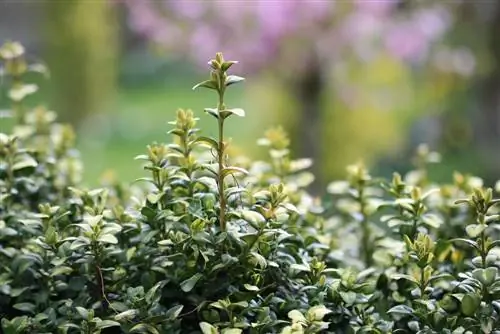
If you have problems overwintering in a cold area every year, you should at some point replace the shivering plant with a boxwood of a more frost-hardy variety:
- ‘Blue Heinz’
- ‘Dee Runk’
- ‘Handsworthiensis’
- ‘Herrenhausen’
- ‘Highlander’
- ‘Monrue’
These varieties are specified for winter hardiness zone 5 and should actually be able to withstand more cold than is ever likely to occur in Germany.
You should avoid variegated-leaved varieties such as 'Elegantissima', they are relatively sensitive to frost and therefore always need a protected location.
Conclusion
Boxwood autumn offers from hardware stores or garden centers usually come from large garden centers in the south. These quickly raised box balls or box spirals should remain in the bucket for life and be overwintered with very good protection.

